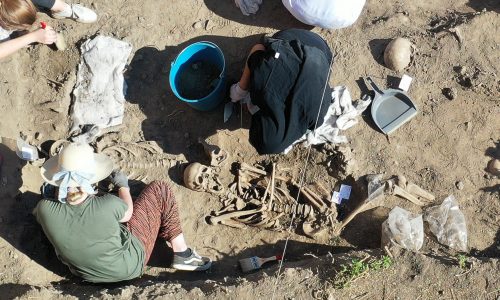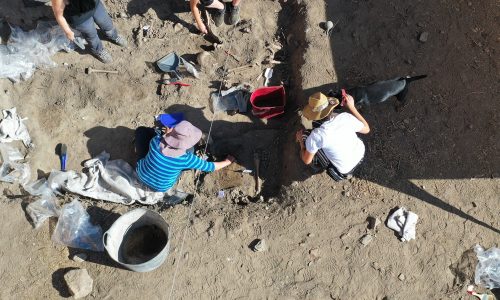Course in Spanish. From March 24 to April 2, 2025.
17:00-20:00 h
UNIVERSITY EXTENSION COURSE. Course code: 21824.
1 ECTs credit.
UNIVERSITY OF ALCALÁ DE HENARES (UAH).
ORGANIZED by: Vice-Rectorate for Graduate Studies, Continuing Education and University Extension of the University of Alcalá (UAH).
COURSE DESCRIPTION
Recognition work of dental paleopathological cases that will be provided to them in the form of photos, videos, radiographs and CT images.
Preparation of a standard dental report on cases of forensic and archaeological origin.
Student profile:
Course designed for members of the State Security Forces and Corps, university students of Criminalistics, Odontology, Law, Criminology, Biology, Archaeology, Chemistry, Pharmacy, Medicine, Paleopathology, Computer Science, Nursing, Electronics and other professionals related to forensic sciences.
And all those with an interest in the knowledge of dental anatomy, its evolution and the diseases that appeared in antiquity, the attempts to cure them, their treatment and their impact on the societies of the past.
Course objective:
- To understand the importance of the study of dental anthropology within the study of human skeletal remains.
- To know the relevance of dental anthropology in the context of forensic medicine.
- To learn a protocol for the extraction of dental data from human skeletal remains.
- To know different types of software dedicated to the study of human dental and oral data.
- Perform an odontogram on the skeletal remains of a problem individual.
- To use radiological and CT images as an essential tool in the study of dental remains in a forensic and archaeological context.
- To know the different methods of age estimation related to dental development and eruption.
- To make an anthropological and paleopathological report from the dental remains of a problem individual.
- Differentiate between anatomical variability and true dental pathology, avoiding diagnostic errors.
Program.
Total teaching hours: 25: 21 theory classes; 4 practical classes.
1.- Introduction to Dental Anthropology.
Terms and definitions.
Dental anatomy. Macro and microstructures of dentin, cementum and enamel.
Differentiation between human and animal dental anatomy.
Dental morphology: incisors, canines, premolars and molars.
Deciduous and permanent dentition.
Evolution of the dentition in man.
Definition of occlusion.
Types of occlusion. Malocclusion.
Methodology for establishing the different types of occlusion in the forensic and archaeological record.
Relations between maxillary and mandibular teeth according to the type of occlusion. Its application in a forensic context.
Pathological features of malocclusion.
Dental development and eruption.
Initiation to the knowledge of dental germs.
Sequence and timing of dental growth. Its application in a forensic context.
Sequence of intrauterine tooth formation.
Sequence of postnatal dental development.
Sequence and timing of tooth eruption.
Study methods. The essential radiological knowledge.
3.- Methods of age estimation based on dental growth and eruption.
Main methods used in anthropometric practice. Pros and cons.
A correct estimation of age, essential for an accurate forensic study.
Dental wear.
Abrasion, attrition and erosion.
Dental microwear.
Dental wear patterns.
Wear and tear as a result of the use of artifacts. The use of the mouth as a third hand.
Different methods relating dental wear and age. Pros and cons.
Intentional cultural modifications in teeth.
Dental anthropometry. Anatomical variability in teeth.
Anthropometric dental measurements. Calculation of indexes.
Anatomical varieties without pathological reflex. ASUDAS method.
Anatomical varieties in the maxilla and mandible.
Retention of hard parts.
Importance of anthropometric measurements and anatomical variability in forensic examination.
6.- Dental pathology.
Periodontitis. Methods of recognition in dry bone.
Calculus. Macro and micrometric study of dental plaque. Methods to record tartar.
Dental caries.
Dental hypoplasia. Etiology and use as a stress marker.
Dental malposition.
Apical cysts and chronic abscesses.
Forensic identification.
Use of radiographic images in forensic dental identification.
Forensic dental examination protocol.
Interpretation of forensic odontograms.
CERTIFICATION
Students who attend and take advantage of the classes of the course will obtain a diploma from the University of Alcalá (UAH) and 1 ECTs credit that can be validated in any Spanish or foreign university. This ECTs credit is valid for the CV and to complete the degree credits.
REGISTRATION and RESERVATION
The number of students is limited and reservations will be made on a first-come, first-served basis.
Enrollment in OsteoResearch is not available. YOU CAN ONLY REGISTER THROUGH THE UNIVERSITY OF ALCALÁ (UAH).
You can enroll in the training courses on the website of the University of Alcalá.
Specifically for the Dental Anthropology Course, you can download the UAH brochure at the following address:
https://posgrado.uah.es/es/extension-universitaria/.galleries/documentos/FOLLETO-CURSO-21824.pdf
DISCOUNT
Price 180€:
Reduced
IUICP members €100
UAH students and unemployed 120 €.
Characteristics of the course
- Conferences 7
- Questionnaires 0
- Duration 25 hours
- Skill level All levels
- Students 12
- Evaluations Yes
Curriculum
- 1 section
- 7 lessons
- 25 hours









